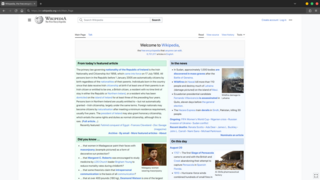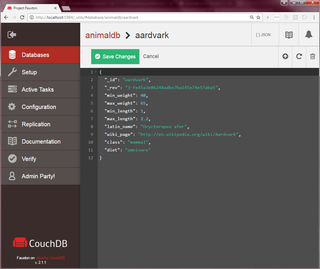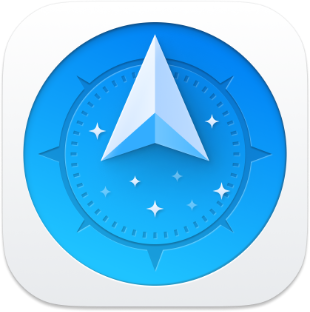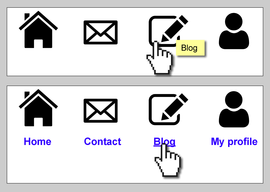
A home page is the main web page of a website. The term may also refer to the start page shown in a web browser when the application first opens. Usually, the home page is located at the root of the website's domain or subdomain. For example, if the domain is example.com, the home page is likely located at www.example.com/.

Lynx is a customizable text-based web browser for use on cursor-addressable character cell terminals. As of 2024, it is the oldest web browser still being maintained, having started in 1992.

Martin Fowler is a British software developer, author and international public speaker on software development, specialising in object-oriented analysis and design, UML, patterns, and agile software development methodologies, including extreme programming.
Web design encompasses many different skills and disciplines in the production and maintenance of websites. The different areas of web design include web graphic design; user interface design ; authoring, including standardised code and proprietary software; user experience design ; and search engine optimization. Often many individuals will work in teams covering different aspects of the design process, although some designers will cover them all. The term "web design" is normally used to describe the design process relating to the front-end design of a website including writing markup. Web design partially overlaps web engineering in the broader scope of web development. Web designers are expected to have an awareness of usability and be up to date with web accessibility guidelines.
In HTML and XHTML, an image map is a list of coordinates relating to a specific image, created in order to hyperlink areas of the image to different destinations. For example, a map of the world may have each country hyperlinked to further information about that country. The intention of an image map is to provide an easy way of linking various parts of an image without dividing the image into separate image files.
Usability engineering is a professional discipline that focuses on improving the usability of interactive systems. It draws on theories from computer science and psychology to define problems that occur during the use of such a system. Usability Engineering involves the testing of designs at various stages of the development process, with users or with usability experts. The history of usability engineering in this context dates back to the 1980s. In 1988, authors John Whiteside and John Bennett—of Digital Equipment Corporation and IBM, respectively—published material on the subject, isolating the early setting of goals, iterative evaluation, and prototyping as key activities. The usability expert Jakob Nielsen is a leader in the field of usability engineering. In his 1993 book Usability Engineering, Nielsen describes methods to use throughout a product development process—so designers can ensure they take into account the most important barriers to learnability, efficiency, memorability, error-free use, and subjective satisfaction before implementing the product. Nielsen’s work describes how to perform usability tests and how to use usability heuristics in the usability engineering lifecycle. Ensuring good usability via this process prevents problems in product adoption after release. Rather than focusing on finding solutions for usability problems—which is the focus of a UX or interaction designer—a usability engineer mainly concentrates on the research phase. In this sense, it is not strictly a design role, and many usability engineers have a background in computer science because of this. Despite this point, its connection to the design trade is absolutely crucial, not least as it delivers the framework by which designers can work so as to be sure that their products will connect properly with their target usership.
Information architecture (IA) is the structural design of shared information environments; the art and science of organizing and labelling websites, intranets, online communities and software to support usability and findability; and an emerging community of practice focused on bringing principles of design, architecture and information science to the digital landscape. Typically, it involves a model or concept of information that is used and applied to activities which require explicit details of complex information systems. These activities include library systems and database development.

Andrew Jay Hertzfeld is an American software engineer who was a member of Apple Computer's original Macintosh development team during the 1980s. After buying an Apple II in January 1978, he went to work for Apple Computer from August 1979 until March 1984, where he was a designer for the Macintosh system software.

Processing is a free graphics library and integrated development environment (IDE) built for the electronic arts, new media art, and visual design communities with the purpose of teaching non-programmers the fundamentals of computer programming in a visual context.
Web development is the work involved in developing a website for the Internet or an intranet. Web development can range from developing a simple single static page of plain text to complex web applications, electronic businesses, and social network services. A more comprehensive list of tasks to which Web development commonly refers, may include Web engineering, Web design, Web content development, client liaison, client-side/server-side scripting, Web server and network security configuration, and e-commerce development.
Digital asset management (DAM) and the implementation of its use as a computer application is required in the collection of digital assets to ensure that the owner, and possibly their delegates, can perform operations on the data files.

XMLHttpRequest (XHR) is an API in the form of a JavaScript object whose methods transmit HTTP requests from a web browser to a web server. The methods allow a browser-based application to make a fine-grained server call and store the results in XMLHttpRequest's responseText attribute. XMLHttpRequest is a component of Ajax programming. Prior to Ajax, hyperlinks and form submissions were the primary mechanisms for interacting with the server, often replacing the current page with another one.

A website wireframe, also known as a page schematic or screen blueprint, is a visual guide that represents the skeletal framework of a website. The term wireframe is taken from other fields that use a skeletal framework to represent 3 dimensional shape and volume. Wireframes are created for the purpose of arranging elements to best accomplish a particular purpose. The purpose is usually driven by a business objective and a creative idea. The wireframe depicts the page layout or arrangement of the website's content, including interface elements and navigational systems, and how they work together. The wireframe usually lacks typographic style, color, or graphics, since the main focus lies in functionality, behavior, and priority of content. In other words, it focuses on what a screen does, not what it looks like. Wireframes can be pencil drawings or sketches on a whiteboard, or they can be produced by means of a broad array of free or commercial software applications. Wireframes are generally created by business analysts, user experience designers, developers, visual designers, and by those with expertise in interaction design, information architecture and user research.
Radmind is a suite of Unix command-line tools and an application server designed to remotely administer the file systems of multiple client machines.
User experience design defines the experience a user would go through when interacting with a company, its services, and its products. User experience design is a user centered design approach because it considers the user's experience when using a product or platform. Research, data analysis, and test results drive design decisions in UX design rather than aesthetic preferences and opinions. Unlike user interface design, which focuses solely on the design of a computer interface, UX design encompasses all aspects of a user's perceived experience with a product or website, such as its usability, usefulness, desirability, brand perception, and overall performance. UX design is also an element of the customer experience (CX), and encompasses all aspects and stages of a customer's experience and interaction with a company.

Apache CouchDB is an open-source document-oriented NoSQL database, implemented in Erlang.
Google App Engine is a cloud computing platform as a service for developing and hosting web applications in Google-managed data centers. Applications are sandboxed and run across multiple servers. App Engine supports automatic scaling for web applications allocating more resources to the web application for handling additional demand as the amount of requests increases for an application.

Web navigation refers to the process of navigating a network of information resources in the World Wide Web, which is organized as hypertext or hypermedia. The user interface that is used to do so is called a web browser.

Sencha Touch is a user interface (UI) JavaScript library, or web framework, specifically built for the Mobile Web. It can be used by Web developers to develop user interfaces for mobile web applications that look and feel like native applications on supported mobile devices. It is based on web standards such as HTML5, CSS3 and JavaScript. The goal of Sencha Touch is to facilitate quick and easy development of HTML5 based mobile apps which run on Android, iOS, Windows, Tizen and BlackBerry devices, simultaneously allowing a native look and feel to the apps.

Path Finder is a Macintosh file browser developed by Cocoatech. First released in 2001 simultaneously with the public release of Mac OS X 10.0 (Cheetah), it replicates or integrates most of the features of the Finder, but introduces additional functionality similar to that found in Windows's File Explorer, the defunct Norton Commander, and other third-party file browsers developed for a variety of platforms.












